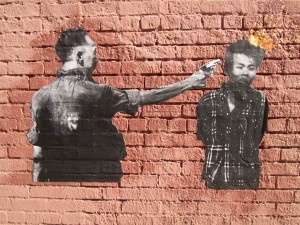Artists should turn to history for inspiration
The outcome of the presidential election not only decides the new leader of the country, but also the course of events for the next four years. Each time a new president steps into office, they assume responsibility for decisions that could affect the country far beyond their term.

Street statement · On this brick wall in Los Angeles, street artist Bumboywc puts a new twist on Eddie Adam’s famous Vietnam War photograph of a South Vietnam police chief pointing a gun at a Vietcong prisoner. – Eva Recinos | Daily Trojan
By opening an American history textbook, citizens today can get a play-by-play of each presidential term and the big events during the presidency that changed the course of history. Yet, an artistic reminder might communicate these important moments more quickly and effectively. Through iconic photographs — and by extension, works of art — viewers can look back at America’s best and worst moments. In seeing these time capsules, they can also link past eras’ events with past presidents and their terms.
That power hopefully leads to learning from our mistakes and understanding the things that help the country progress and those that hinder its growth. What artists today should take into consideration is their unique ability to capture certain moments so they will not be forgotten.
Associated Press photographer Eddie Adams caught such a moment during the Vietnam War — one of the most contested, talked-about events in American history — when a South Vietnam police chief blatantly put a gun up to the head of a Vietcong prisoner to kill him. Adams caught the stark violence of the war and, as an American photographer, displayed the involvement of America in Vietnam’s actions.
Today, a reproduction of this image resides on a brick wall in Los Angeles across from a liquor store. The wheatpaste work features only the two major figures in the photograph. Candy corn flies out of the head of the Vietcong man.
The image comes from street artist Bumboywc, whose work tackles everything from politics to popular culture. In a different location, the artist also pasted a work depicting President Barack Obama asking for spare change in a cup, holding up a sign bearing the his 2008 campaign slogan “CHANGE?” with a puppet-Mitt Romney handing him a dollar. As the election draws closer, many street artists have pasted similar images along the streets with the candidates’ images reproduced in a variety of situations.
The image of the Vietcong man shot with candy corn bursting out of his brain might seem dangerously satirical at first, substituting blood for a common Halloween candy. Yet, that very decision might indicate the artist’s message — art shouldn’t focus on just creating creepy pictures for our delight, but also creating haunting pieces, such as Adams’, that will serve as a lasting reminder of the past.
Art is as an important medium for preserving the present for future generations. It also helps current citizens understand just what occurs during their chosen president’s term. Each event that takes place can be recorded and transformed under the aesthetic styles of each artist, as Bumboywc does; if artists decide to engage in the present events of their era they can capture them as a means of getting citizens to think more closely about them. Their art can serve as a means of evaluating the decisions a president makes during his term.
Bumboywc most likely chose the image because of the photo’s familiarity to so many people. That the image survived the passage of decades and remains one of the most recognizable photographs in history indicates that photography exists as an important medium in the art world and visual language doesn’t confine itself to labels — especially when out in the streets.
Street art, in particular, proves a powerful tool for thought. Bumboywc’s decision to paste his work somewhere as routine as a brick wall near a liquor store and a residential area causes passers-by to look twice. When they do, they also might pause to assess America’s history, their own present and the possibilities of the future. Art can reach across demographic categories and affect everyone from the art historian to passers-by that are not even old enough to vote. That power should be taken with care, under the hands of those looking to benefit society, not harm it.
Bumboywc’s street art piece might not last very long — a law official will probably come take it down — but its impact for the period of time it stays up could prove more lasting. Each time that one artist takes a political matter into his or her hands, he or she can inspire others. If a few artists begin to allot more time and attention to current events, others in the art world can start to move in the same direction.
The power of an image can cause both positive and negative effects, in that it captures a moment and evokes emotion quickly. Though artists should not be afraid to tackle current events in their work, art viewers must also approach these works with a critical eye. The new president will be decided today and after that, only time will tell what happens — and, consequently, how artists decide to record those events.
Eva Recinos is a senior majoring in English. Her column “Two Cents A Piece” runs Tuesdays.
